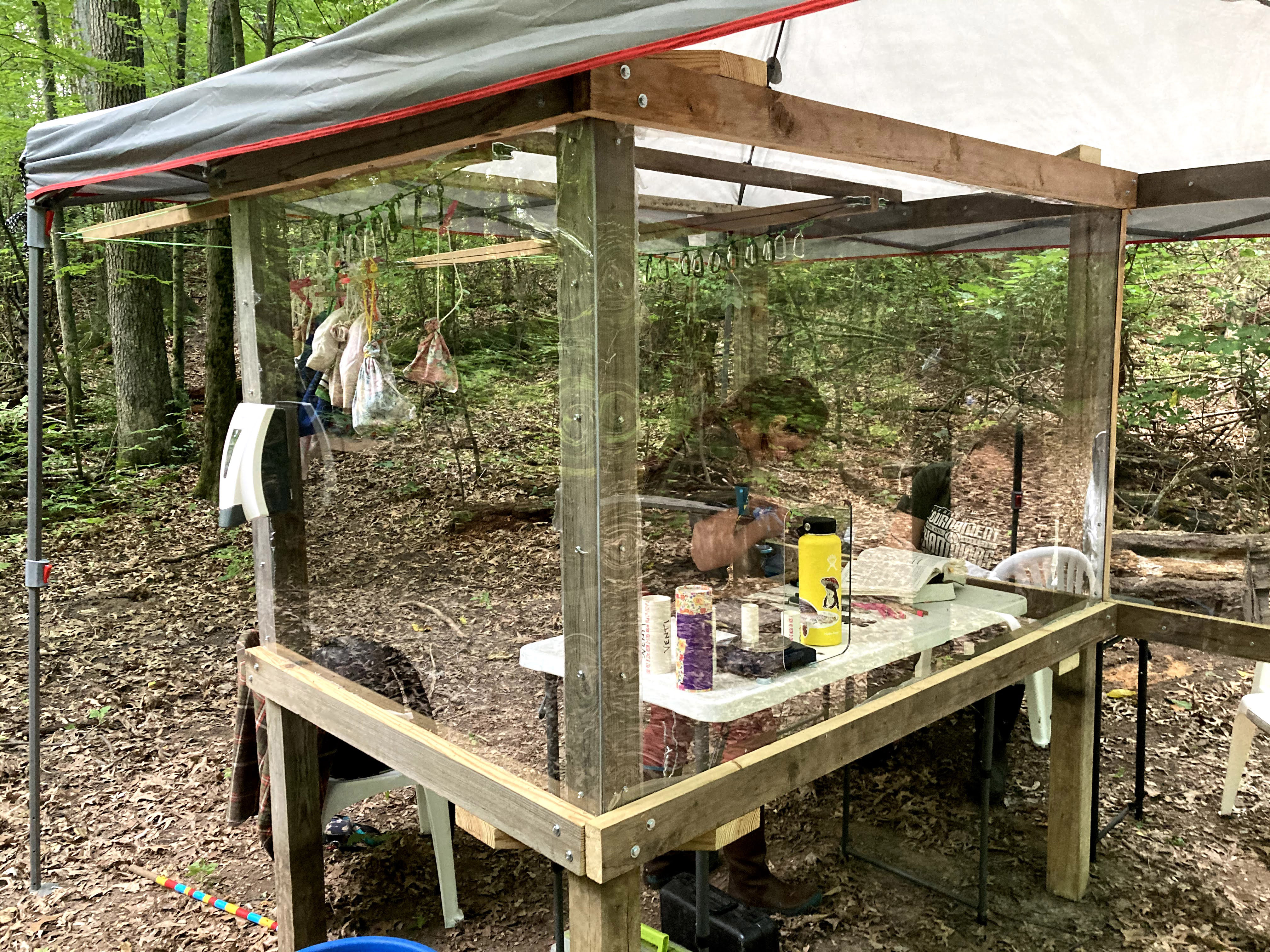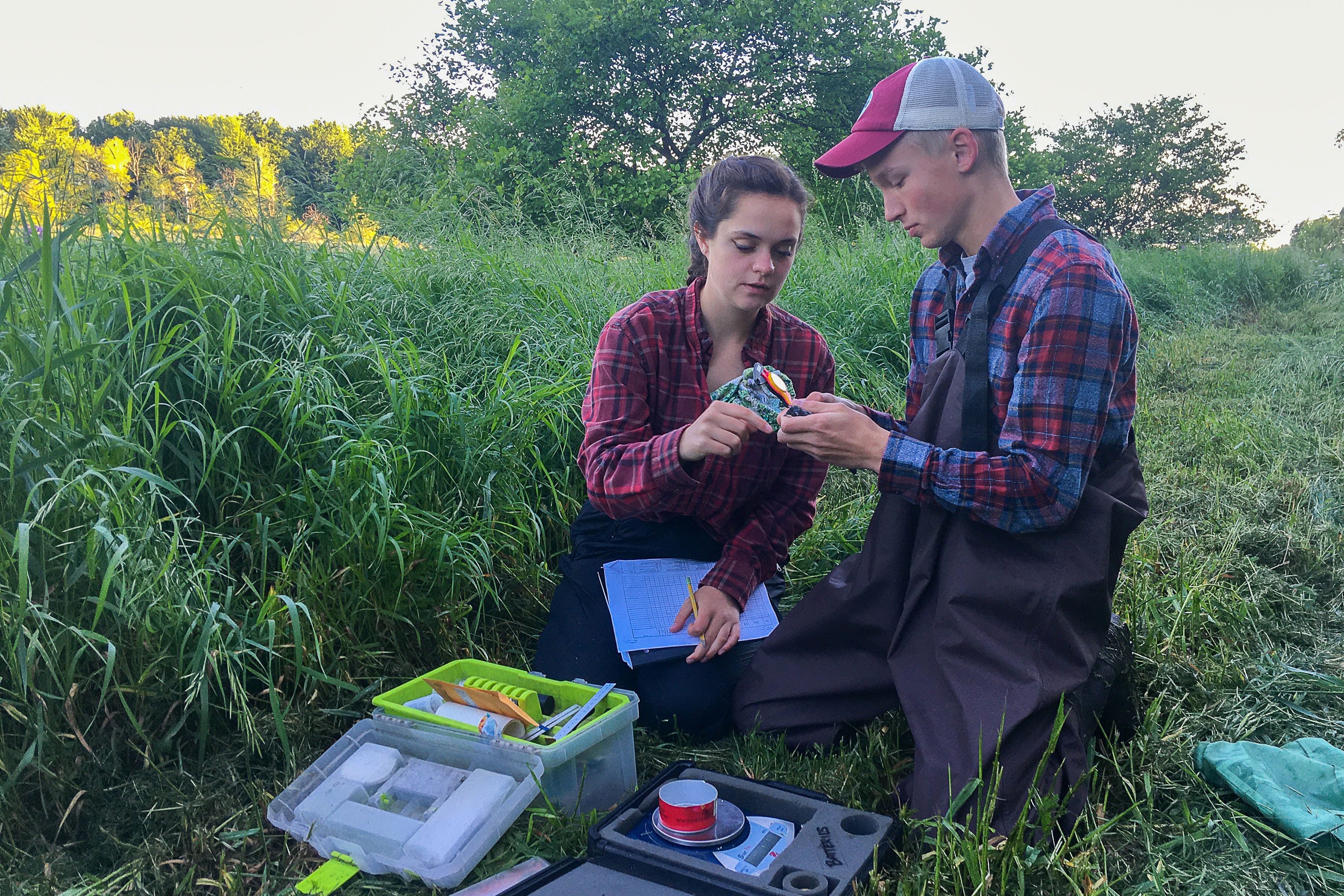Student-led bird banding innovation spearheads continuation of data collection despite COVID-19
Two fisheries and wildlife undergraduate students, Hannah Landwerlen and Evan Griffis, designed and built a box that allows bird banding to be performed safely during the novel coronavirus pandemic.

As the novel coronavirus pandemic began shuttering many business operations worldwide in March 2020, uncertainties abounded. There were more questions than answers, from personal and community health concerns to navigating new restrictions in the workplace.
Like many scientists, Jen Owen, an associate professor in the Michigan State University Department of Fisheries and Wildlife, endeavored to continue her research uninterrupted. She wondered how it could be done safely to avoid data gaps.
Owen, who also holds an appointment in the Department of Large Animal Clinical Sciences, and her team study behavior and disease ecology in migratory birds. She has collected more than a decade’s worth of data through bird banding. Using this essential tool, scientists can learn about population size, dispersal, behavior, disease prevalence and life span, among other information.
Researchers have been banding birds since the dawn of the 19th century, employing a variety of techniques. Mist nets made of fine mesh material are used for capture of small songbirds like the ones Owen studies, with removal performed by trained field staff.
Following capture, an assortment of data points and health measurements are recorded, including species, sex, weight and wing length. For birds being newly banded, a small aluminum band with a unique identification number is wrapped around the bird’s leg. Being mindful of placing too much stress on the birds, scientists move swiftly to release them.
The bird banding program is federally run by the U.S. Geological Survey’s Bird Banding Laboratory, which serves as the nation’s band supplier and repository for all U.S. banding data.
The bulk of Owen’s data is from the Burke Lake Banding Station in Bath, Michigan, roughly 10 miles northeast of the MSU campus and located on the Michigan Department of Natural Resource’s Rose Lake State Wildlife Research Area.
Recently, additional bird banding has taken place at the MSU Corey Marsh Ecological Research Center, which opened in November 2018 in Laingsburg, Michigan, at the site of the former Muck Soils Research Farm. Owen is the director at Corey Marsh, which sits just two miles northeast of the Burke Lake Banding Station. To encapsulate the work at both locations and the growing emphasis on outreach programming, the Michigan State Bird Observatory was founded.
“We have a long-term dataset, and if we took a year off because of the coronavirus, it could leave significant knowledge gaps,” Owen said. “We had to come up with a solution quickly, which increases the pressure on everyone. Thankfully I have a great group that took on the challenge.”
Necessity is the mother of invention
For the uninitiated, bird banding is a fascinating spectacle to behold, one that requires a keen eye and a practiced hand. The very nature of it complicates safety matters during a global pandemic. That’s because the primary bird handler collecting data must remain maskless.
To identify a bird’s fat storage — a key health indicator — specially trained researchers use their mouths to blow apart feathers, looking for small yellow sacs of fat located underneath. Determining other traits such as sex may necessitate blowing to separate feathers as well.
“This isn’t a normal laboratory situation where I can simply tell people to wear masks and stand six feet apart,” Owen said. “Blowing on the birds is really the only way to determine fat storage, which is one of our most important pieces of information on each bird. It tells us a lot about their overall health and whether they are getting fat enough to make their migratory journey. We had to come up with a way to allow the bander to be maskless while other field staff wearing masks were still around to record data and help with the process.”

Owen asked her team for ideas, and what emerged was a practical, elegant solution: Build a three-sided structure in which the bander can sit at a table without a mask. The wooden frame is fitted with plexiglass sides, and a small hole allows for birds to be released after measurements are taken. Two wooden poles with pulleys extend from the back of the box, allowing masked individuals outside to attach bags that each contain a bird. When ready, the bander uses the pulley system to bring the next bird inside.
Modifications have been made to improve the design, such as a microphone for communication with those outside of the box. Other bird banding stations have taken notice.
“We posted photos and a description of the box on Facebook and immediately received positive feedback,” Owen said. “We’ve had bird banding stations reach out to us and ask about the design. All stations were concerned about a lost season, so seeing something that allowed us to do the research resonated with them.”
Pursuing a passion
In a university-based research setting, praise is frequently heaped on faculty, and for good reason. But an array of staff, postdoctoral researchers, graduate students and undergrads take part in the day-to-day grind of long-term research, often without much fanfare. It’s from these individuals where some of the most innovative ideas come.
Leading the design efforts for the bird banding box were two fisheries and wildlife undergraduate students, Hannah Landwerlen and Evan Griffis, who each brought excitement and a different skill set to the process.
Landwerlen, who has since graduated with her bachelor’s degree in fisheries and wildlife, was a member of Owen’s research team for the majority of her undergraduate tenure.
“I’m from southeast Michigan, so I didn’t grow up around wildlife in a rural area, but my dad took me to a local state park where we observed animals,” she said. “We both love wildlife photography, and I’ve enjoyed sharing that with him. Because of that, I knew I wanted to work with animals in some way.”
As a freshman with her sights set on a degree in zoology and eventually veterinary school, Landwerlen began browsing MSU websites for potential research opportunities.

“I noticed that a lot of other pre-vet students were getting internships and other experience, so I wanted to take part in research,” Landwerlen said. “I saw a doctoral student of Jen’s working with West Nile virus in American robins. I applied to be a part of that project, and it was the beginning of seeing career possibilities I didn’t know about.”
Extracting birds from mist nets was one of the initial tasks to master. She excelled and wanted to know more about birds and the banding process. As a sophomore, Landwerlen became a mist net intern, handling birds for a variety of banding projects. A conversation with Owen prompted a change of major to fisheries and wildlife.
Landwerlen was an integral part of establishing the bird banding program at Corey Marsh, and after the pandemic began, she was motivated to create a safe way to continue it. Her knowledge of the banding process and the needs of the bander came in handy during design of the box.
“I can’t say enough good things about Hannah and her dedication,” Owen said. “She has been such a wonderful team member for years now, and although I’m thrilled to see her move into the next phase of her life, I’m going to miss her contributions.”
In March 2021, Landwerlen journeyed to Florida for a temporary position at the Archbold Research Station studying the endangered Florida grasshopper sparrow. While she hasn’t decided her exact professional path, she said a research position in academia may be down the road.
“I’ve learned so much about bird banding and disease ecology from Jen and appreciate working with her,” Landwerlen said. “She had a huge impact on my career choice, which I believe sets me up to do any number of things in the future.”
Unlike Landwerlen, Griffis grew up surrounded by nature in Michigan’s Upper Peninsula. His enthusiasm for birdwatching began when he was a teenager, rapidly shifting from hobby to career goal. Griffis refers to the common redpoll, a small member of the finch family, as his “spark” bird — the species that got him hooked on birdwatching.
Upon graduating from high school, Griffis was confident that fisheries and wildlife was the major for him, selecting MSU due to its prestige in the field. He soon got involved with the Burke Lake Banding Station and heard about the efforts at Corey Marsh.
“The extensive bird research was the initial draw to MSU for me, but Corey Marsh provided the opportunity to do a lot more,” said Griffis, now a sophomore. “Being a field technician there has allowed me to get involved with all sorts of activities, such as building the banding box. I enjoy building things, so this was a good chance to practice those skills in a very practical way.”
Griffis put his construction expertise on display with his thoughtful design contributions and carpentry acumen. He helped compile a list of needed materials for the banding box and did most of the building alongside Landwerlen.
After the box was completed, he asked Owen if there were other projects at Corey Marsh. She mentioned that the walking trails needed attention, and the two devised a plan as winter approached.
“I have been cross-country skiing since I was a kid,” Griffis said. “Jen and I both said if we widened the trails at Corey Marsh, it would be an awesome place to ski. There aren’t many groomed trails in the Lansing area, and Jen let me have a lot of freedom to do what I wanted, so I ran with it.”
Maintaining the trails, however, is no easy task. Using his ingenuity, Griffis fashioned a trail groomer and has kept the paths in superb shape throughout the skiing season. He said Corey Marsh has hosted many skiers and receives a multitude of skiing inquiries, something he has taken pride in as he watches the community enjoy the fruits of his labor.
Owen marvels at the drive shown by Griffis to learn and grow, both as a team member and scientist.
“I’m really fortunate to have talented and passionate students, and Evan is the perfect example of that,” she said. “We couldn’t have made the progress we have with banding or with Corey Marsh operations without him. I am excited that Evan is around for another couple years to contribute to our migratory bird research, but I also really look forward to seeing how his experiences at MSU shape the path he follows after he graduates.”



 Print
Print Email
Email
